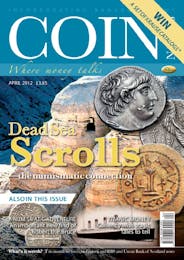The good old days?
IN THIS month’s magazine you will find an advert for a “medallic coin” to celebrate the forthcoming Diamond Jubilee of Her Majesty the Queen. As it has no monetary value or legal tender status it isn’t a coin per se, but it certainly bears more resemblance to a traditional crown than a “medallion” and it is fairly certain that this, or items similar to this, will be the mainstay of numismatic celebrations for the Jubilee. Over the long weekend of June 2–5, 2012 it is likely that either this medallic coin, the official £5 crown from the Royal Mint or other such coin-like strikings, will be the pieces handed out by schools, youth groups, churches, etc. They will also be the presents given by grandparents to their grandchildren and the promotional items used by companies wishing to commemorate this historic event. Now, without wishing to take anything away from the “coins” on offer—some are truly lovely—I can’t help but feel a twinge of sadness at the knowledge that because such items are commercially available, are of good quality and are reasonably affordable, it is unlikely that we will see a return to the days of the last Diamond Jubilee, in 1897, when individual towns, societies, institutions, etc., each produced their own numismatic tribute to the Monarch’s long reign.
New metals and alloys and the relative ease of production that the Industrial Revolution had enabled, meant that getting a medal struck was no longer the preserve of the big mints and the late 19th century saw a plethora of medallions and medals produced for just about everything from anniversaries to prizes for the “Best bull in show” and an event such as the unprecedented Diamond Jubilee of Queen Victoria was the perfect excuse for every engraver and artist in the Empire to get their work made metal. These medals are now eminently collectable and if you go to any reasonably large coin show anywhere in the country you will see a number of dealers who have a wonderful selection of such items: Tim Millet, Simon Monks, Richard Gladdle, Charles Riley, Chris Eimer, Daniel Fearon, Jan Lis, P&D Medallions and others are all well known in the trade and in the hobby that they are considered every bit a mainstream numismatic dealer as anyone else you see at Coinex, the London Coin Fair, York or Harrogate. None of them include many coins in their main stock—they all specialise in medals and there are enough collectors interested in what they have to ensure that they remain in business. In short, such medals are highly prized in our hobby. Without them numismatics would be a poorer place and whilst they don’t enjoy the glamour of hammered gold or Athenean owls or the availability of milled silver, they are every bit as collectable as anything else a bourse has to offer. Therefore I cannot help but think it a great shame that the heyday of such items may well be over. Nowadays a prize bull at an agricultural show receives a rosette and little more. Societies and institutions are more likely to give plasticky gilt-coloured cups and stay-bright shields engraved by the local key-cutter than a carefully crafted medal, and companies are more likely to entice new customers with BOGOFS and money-off coupons than with beautifully designed numismatica (remember the Cadbury’s Cocoa medals?). Town councils are too busy watching the pennies, and too conscious of elections, to dare commission such metal extravagance and schools and youth groups are more likely to choose the mass produced offering than ever try to create their own.
As I said, please do not misunderstand me: the coins and “medallic coins” being offered really are very pleasant. They have an aesthetic appeal that belies their mass production. They are not (or at least most are not) the numismatic equivalent of the stay-bright shield and anyone receiving one from a school or grandparent will, I am sure, be grateful, and rightly so. But nor are these the medallions of old. They are very much struck as coins not medals and I do feel that because of that they lack a little something. Perhaps it is because we use coins every day that I yearn for celebrations such as this to be commemorated by something more substantial.
Perhaps it is because with coins everyone immediately wants to know “what is it worth?” whereas with medals they can, sometimes, appreciate the aesthetic value over the monetary worth. But I suspect this desire of mine to see a return to towns, institutions, societies and schools creating their own medals for something like the Jubilee and not use those commercially available, is nothing to do with pure nostalgia and everything to do with my wish to acquire all the ones local to me— such is the nature of a collector!

Archives
-
2024 (15 articles)
-
2023 (55 articles)
-
2022 (44 articles)
-
2021 (59 articles)
-
2020 (80 articles)
-
2019 (50 articles)
-
2018 (49 articles)
-
2017 (46 articles)
-
2016 (54 articles)
-
2015 (44 articles)
-
2014 (62 articles)
-
2013 (75 articles)
-
2012 (74 articles)
-
2011 (81 articles)
-
2010 (131 articles)
-
2009 (91 articles)
-
2008 (89 articles)
-
2007 (75 articles)
-
2006 (76 articles)
-
2005 (19 articles)
-
2004 (11 articles)
-
2003 (23 articles)
-
2002 (16 articles)
-
2001 (11 articles)









